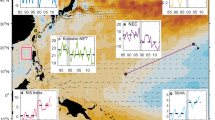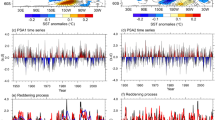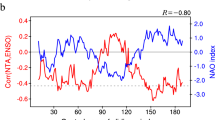Abstract
Decadal climate prediction presumes there are decadal-timescale processes and mechanisms that, if initialized properly in models, potentially provide predictive skill more than one or two years into the future. Candidate mechanisms involve Pacific decadal variability and Atlantic multidecadal variability, elements of which involve slow fluctuations of tropical Pacific and Atlantic sea surface temperatures (SSTs) from positive anomalies (positive phase) to negative anomalies (negative phase). Here we use model experiments to show that there tends to be a weak opposite-sign SST response in the tropical Pacific when observed SSTs are specified in the Atlantic, while there is a weak same-sign SST response in the tropical Atlantic when observed SSTs are specified in the tropical Pacific. Net surface heat flux in the Atlantic and ocean dynamics in the Pacific play contrasting roles in the ocean response to specified SSTs in the respective basins. We propose that processes in the Pacific and Atlantic are sequentially interactive through the atmospheric Walker circulation along with contributions from midlatitude teleconnections for the Atlantic response to the Pacific.
This is a preview of subscription content, access via your institution
Access options
Access Nature and 54 other Nature Portfolio journals
Get Nature+, our best-value online-access subscription
$29.99 / 30 days
cancel any time
Subscribe to this journal
Receive 12 print issues and online access
$259.00 per year
only $21.58 per issue
Buy this article
- Purchase on Springer Link
- Instant access to full article PDF
Prices may be subject to local taxes which are calculated during checkout





Similar content being viewed by others
Data availability
HadISST data are available from https://www.metoffice.gov.uk/hadobs/hadisst/. The ERA-I data are available from https://www.ecmwf.int/en/forecasts/datasets/reanalysis-datasets/era-interim. ERSSTv4 data are available from https://www.ncdc.noaa.gov/data-access/marineocean-data/extended-reconstructed-sea-surface-temperature-ersst-v4.
Code availability
Previous and current CESM versions are freely available at www.cesm.ucar.edu:/models/cesm2/. The CESM solutions/datasets used in this study are also freely available from the NCAR Digital Asset Services Hub (DASH) at data.ucar.edu or from the links provided from the CESM website at www.cesm.ucar.edu.
References
McGregor, S. et al. Recent Walker circulation strengthening and Pacific cooling amplified by Atlantic warming. Nat. Clim. Change https://doi.org/10.1038/NCLIMATE2330 (2014).
McGregor, S. et al. Model tropical Atlantic biases underpin diminished Pacific decadal variability. Nat. Clim. Change https://doi.org/10.1038/s41558-018-0163-4 (2018).
Ruprich-Robert, Y. et al. Assessing the climate impacts of the observed Atlantic multidecadal variability using the GFDL CM2.1 and NCAR CESM1 global coupled models. J. Clim. 30, 2785–2810 (2017).
Levine, A. F. Z., McPhaden, M. J. & Frierson, D. M. W. The impact of the AMV on multidecadal ENSO variability. Geophys. Res. Lett. 44, 3877–3886 (2017).
Geng, X., Zhang, W. & Jin, F.-F. Modulation of the relationship between ENSO and its combination mode by the Atlantic multidecdal oscillation. J. Clim. 33, 4679–4695 (2020).
Yang, Y.-M., An, S.-I., Wang, B. & Park, J. H. A global-scale multidecadal variability driven by Atlantic multidecadal oscillation. Natl Sci. Rev. 7, 1190–1197 (2020).
Kumar, A., Bhaskar, J. & Wang, H. Attribution of SST variability in global oceans and the role of ENSO. Clim. Dyn. 43, 209–220 (2014).
Taschetto, A. S., Rodrigues, R. R., Meehl, G. A., McGregor, S. & England, M. H. How sensitive are the Pacific–North Atlantic teleconnections to the position and intensity of El Niño-related warming. Clim. Dyn. https://doi.org/10.1007/s00382-015-2679-x (2015).
Meehl, G. A., Hu, A., Santer, B. D. & Xie, S.-P. Contribution of the Interdecadal Pacific Oscillation to twentieth-century global surface temperature trends. Nat. Clim. Change https://doi.org/10.1038/nclimate3107 (2016).
Li, X., Xie, S.-P., Gille, S. T. & Yoo, C. Atlantic-induced pan-tropical climate change over the past three decades. Nat. Clim. Change https://doi.org/10.1038/NCLIMATE2840 (2015).
Cai, W. et al. Pantropical climate interactions. Science 363, eaav4236 (2019).
Elsbury, D. et al. The atmospheric response to positive IPV, positive AMV, and their combination in boreal winter. J. Clim. 32, 4193–4213 (2019).
Nigam, S., Sengupta, A. & Ruiz-Barradas, A. Atlantic–Pacific links in observed multidecadal SST variability: is the Atlantic multidecadal oscillation’s phase reversal orchestrated by the Pacific decadal oscillation? J. Clim. 33, 5479–5505 (2020).
Meehl, G. A., Chung, C. T. Y., Arblaster, J. M., Holland, M. M. & Bitz, C. M. Tropical decadal variability and the rate of Arctic sea ice retreat. Geophys. Res. Lett. https://doi.org/10.1029/2018GL079989 (2018).
Meehl, G. A., Arblaster, J. M., Bitz, C., Chung, C. T. Y. & Teng, H. Antarctic sea ice expansion between 2000–2014 driven by tropical Pacific decadal climate variability. Nat. Geosci. https://doi.org/10.1038/NGEO2751 (2016).
Meehl, G. A. et al. Sustained ocean changes contributed to sudden Antarctic sea ice retreat in late 2016. Nat. Commun. 10, 14 (2019).
Booth, B. B. B., Dunstone, N. J., Halloran, P. R., Andrews, T. & Bellouin, N. Aerosols implicated as a prime driver of twentieth-century North Atlantic climate variability. Nature 484, 228–232 (2012).
Smith, D. M. et al. Role of volcanic and anthropogenic aerosols in the recent global surface warming slowdown. Nat. Clim. Change https://doi.org/10.1038/NCLIMATE3058 (2016).
Watanabe, M. & Tatebe, H. Reconciling roles of sulphate aerosol forcing and internal variability in Atlantic multidecadal climate changes. Clim. Dyn. 53, 4651–4665 (2019).
Cassou, C. et al. Decadal climate variability and predictability. Bull. Am. Meteorol. Soc. https://doi.org/10.1175/BAMS-D-16-0286.1 (2018).
Kay, J. E. et al. The Community Earth System Model (CESM) large ensemble project: a community resource for studying climate change in the presence of internal climate variability. Bull. Am. Meteorol. Soc. 96, 1333–1349 (2015).
Ting, M., Kushnir, Y., Seager, R. & Li, C. Forced and internal twentieth-century SST trends in the North Atlantic. J. Clim. 22, 1469–1481 (2009).
Smith, T. M., Reynolds, R. W., Peterson, T. C. & Lawrimore, J. Improvements to NOAA’s historical merged land–ocean surface temperature analysis (1880–2006). J. Clim. 21, 2283–2296 (2008).
Kosaka, Y. & Xie, S.-P. Recent global-warming hiatus tied to equatorial Pacific surface cooling. Nature 501, 403–407 (2013).
Schneider, D. P. & Deser, C. Tropically driven and externally forced patterns of Antarctic sea ice change: reconciling observed and modeled trends. Clim. Dyn. https://doi.org/10.1007/s00382-017-3893-5 (2017).
Trenberth, K. E. & Shea, D. R. Atlantic hurricanes and natural variability in 2005. Geophys. Res. Lett. https://doi.org/10.1029/2006GL026894 (2006).
Acknowledgements
Portions of this study were supported by the Regional and Global Model Analysis (RGMA) component of the Earth and Environmental System Modeling Program of the US Department of Energy’s Office of Biological & Environmental Research (BER) via National Science Foundation IA 1947282. This work also was supported by the National Center for Atmospheric Research, which is a major facility sponsored by the National Science Foundation (NSF) under Cooperative Agreement No. 1852977. F.C. was supported by the NSF under the Collaborative Research EaSM2 Grant OCE-1243015 and EaSM3 Grant OCE-1419569 and by the NOAA Climate Program Office under the Climate Variability and Predictability Program Grant NA13OAR4310138. J.M.A., M.H.E. and S.M. were supported by the Australian Research Council through grant CE110001028, while S.M. was also supported by the Australian Research Council through grant FT160100162. Computing resources (https://doi.org/10.5065/D6RX99HX) were provided by the Climate Simulation Laboratory at NCAR’s Computational and Information Systems Laboratory, sponsored by the National Science Foundation and other agencies.
Author information
Authors and Affiliations
Contributions
G.A.M. directed this work with contributions from all authors. G.A.M., A.H. and F.C. performed the analyses. All of the authors discussed the results and contributed to writing the manuscript.
Corresponding author
Ethics declarations
Competing interests
The authors declare no competing interests.
Additional information
Peer review information Primary Handling Editor: James Super. Nature Geoscience thanks Mingfang Ting, Yu Kosaka and the other, anonymous, reviewer(s) for their contribution to the peer review of this work.
Publisher’s note Springer Nature remains neutral with regard to jurisdictional claims in published maps and institutional affiliations.
Supplementary information
Supplementary Information
Supplementary Figs. 1–10 and Discussion
Rights and permissions
About this article
Cite this article
Meehl, G.A., Hu, A., Castruccio, F. et al. Atlantic and Pacific tropics connected by mutually interactive decadal-timescale processes. Nat. Geosci. 14, 36–42 (2021). https://doi.org/10.1038/s41561-020-00669-x
Received:
Accepted:
Published:
Issue Date:
DOI: https://doi.org/10.1038/s41561-020-00669-x
This article is cited by
-
Recent pronounced warming on the Mongolian Plateau boosted by internal climate variability
Nature Geoscience (2024)
-
Interdecadal tropical Pacific–Atlantic interaction simulated in CMIP6 models
Climate Dynamics (2024)
-
Challenges with interpreting the impact of Atlantic Multidecadal Variability using SST-restoring experiments
npj Climate and Atmospheric Science (2023)
-
Seasonally-reversed trends in the subtropical Northwestern Pacific linked to asymmetric AMO influences
Scientific Reports (2023)
-
Interannual variation in the East Asian summer monsoon-tropical Atlantic SST relationship modulated by the Interdecadal Pacific Oscillation
npj Climate and Atmospheric Science (2023)



